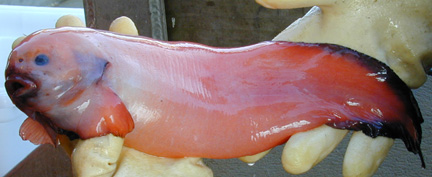
Mesopelagic fishes and squids live in the mid depths of the open ocean. They are critical components in the diet of apex predators that are the marine mammals, birds, and near-bottom dwelling fishes in the eastern Bering Sea. Despite the importance of mesopelagic fishes and squids in the food chain, very few studies have been conducted in this region. We know quite a bit about mesopelagic fishes and squids of the western Bering Sea from 25 years of Russian surveys. Many of our expectations of what to find in the eastern Bering Sea are based on these Russian surveys. A recent study in the eastern Bering Sea, based on bycatch data from commercial fishing, indicated relatively high abundance of mesopelagic fishes within the Green Belt, an area of enhanced productivity that traces the continental slope. This area also has historically high densities of marine mammals, many now endangered or depleted, most of which prey upon mesopelagic fishes and squids.
A pilot study was designed to identify mesopelagic fishes and squids that occur at different depths in the southeastern Bering Sea Green Belt, to characterize their habitat and predators (marine mammals and birds), and to describe the physical mechanisms that define that habitat. The study was mounted with support from the National Oceanic and Atmospheric Administration (NOAA) through Fisheries-Oceanography Coordinated Investigations (FOCI) and the Cooperative Institute for Arctic Research, a joint institute of NOAA and the University of Alaska Fairbanks.
In May 1999, marine mammologists and biologists from NOAA's Alaska Fisheries Science Center and physical oceanographers from NOAA's Pacific Marine Environmental Laboratory undertook a nine-day cruise aboard the NOAA ship Miller Freeman (Fig. 1). Specific cruise instructions are available at http://www.pmel.noaa.gov/foci/operations/instructions/1999/MF9907F.html. Cruise scientists completed 15 midwater trawls, 45 vertical soundings of ocean temperature and density (CTDs), deployed four satellite-tracked drifters, and conducted visual observations of marine mammals from the ship's flying bridge while underway between fishing stations. Figure 2 is a map of the ship's operations.
Figure 1. The research ship -Looking aft toward the trawl ramp aboard the NOAA Ship Miller Freeman. The mountains in the background are the Aleutian Islands.
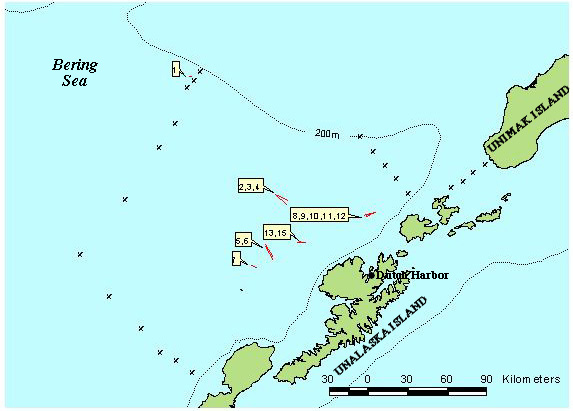
Figure 2. Map of cruise -The area sampled during the May 1999 cruise was north of the Aleutian Islands over the southeastern part of the Bering Sea basin. Trawl locations are indicated by red lines with numbered labels. CTD locations are marked by x's.
The physical and biological data are still in preliminary
stages of analysis, but some general trends stand out.
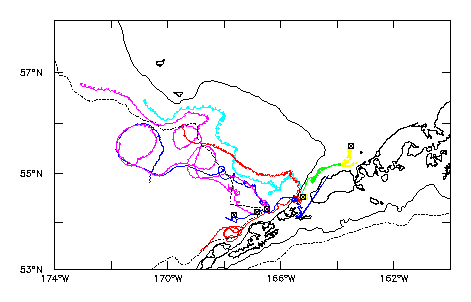
 |
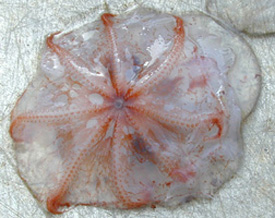 |
| Figure 4. The haul is transferred from the net to the sorting tank in small batches. | Figure 5. This pelagic octopod (probably one of the family Cirroteuthidae) is about 20 cm (8 in) in diameter. |
 |
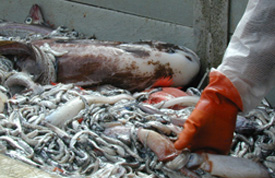 |
| Figure 6. Squid - These squid from three genera of the family Gonatidae: Gonatopsis borealis, Berryteuthis magister, and Gonatus sp.,range in length from about 18 cm to over 60 cm (7 in to 2 ft). | Figure 7. A typical net haul - Samples have been transferred from the net to the sorting bin on deck. |
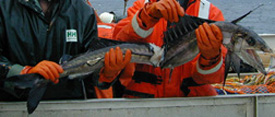 |
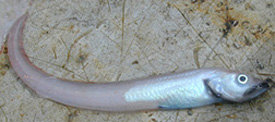 |
| Figure 8. This longnose lancetfish (Alepisaurus ferox), damaged in the net, is about 1.8 m (6 ft) long. | Figure 9. A young blackmouth eelpout (Lycodapus fierasfer). Samples ranged in size from about 15 to 30 cm (6 to 12 in). |
 |
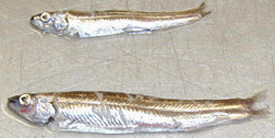 |
| Figure 10. This deepsea red shrimp (Pasiphaea tarda) is about 10 cm (4 in) long. | Figure 11. These are northern smoothtongue (Leuroglossus stilbius) measuring about 10 to 20 cm (4 to 8 in). |
Further reading
Sinclair, E.H., A.A. Balanov, T. Kubodera, V.I. Radchenko, and Y.A. Fedorets. 1999. Distribution and ecology of mesopelagic fishes and cephalopods. In: Loughlin, T.R. and K. Ohtani (eds.), Dynamics of the Bering Sea. University of Alaska Sea Grant, Fairbanks, Alaska 99775-5040, pp. 485-508.
Stabeno, P.J., J.D. Schumacher, and K. Ohtani. 1999.
The physical oceanography of the Bering Sea. In: Loughlin,
T.R. and K. Ohtani (eds.),
Dynamics
of the Bering Sea. University of Alaska Sea Grant, Fairbanks, Alaska
99775-5040, pp. 1-28.
|
FOCI Project Office |